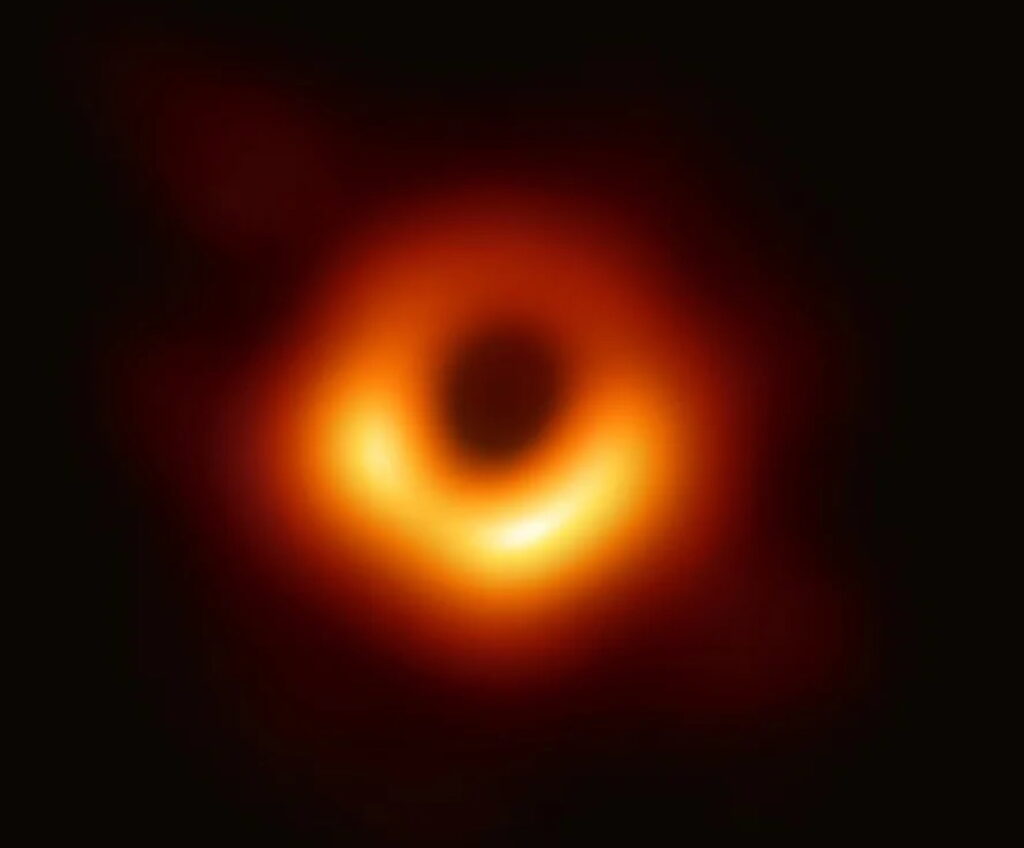Category: astronomy

Ejected Star: How fast is fast?
Earlier today, Genevieve O’Hagan updated Lifeboat readers on this week’s momentous event in Astronomy. At least, I find it fascinating—and so, I wish to add perspective…
30 years ago, astronomer Jack Hills demonstrated the math behind what has become known as the “Hills Mechanism”. Until this week, the event that he described had never been observed.* But his peer astronomers agreed that the physics and math should make it possible…
Hills explained that under these conditions, a star might be accelerated to incredible speeds — and might be even flung out of its galaxy:
- Suppose that a binary star passes close to a black hole, like the one at the center of our galaxy
- The pair of self-orbiting stars is caught up in the gravity well of a black hole, but not sucked in
If conditions are right, one star ends up orbiting the back hole while the other is jettisoned at incredible speed, yet holding onto its mass and shape. All that energy comes from the gravity of the black hole and the former momentum of the captured star. [20 sec animation] [continue below]

This week, astronomers found clear evidence of this amazing event and traced it back to our galactic center: Five million years ago — as our ancestors learned to walk upright — a star that passed close to the massive black hole at The Milky Way center was flung away at a staggering 6 million Kmh. It is traveling so fast, that it is no longer bound to our galaxy or galactic cluster. It is headed out of the galaxy.
- Rifle Bullet: Can exceed Mach 3 (2,300 mph)
- Apollo Rocket: Reached 25,000 mph; Earth escape velocity.
- Juno Probe: 165,000 mph, a record prior to 2019. (It used Jupiter’s gravity to accelerate)
- Parker Probe: 213,000 mph (Nov 2019), but will soon reach 430,000 in a tight arc around the Sun
* Prior to this week, astronomers have observed a few stars traveling inexplicably at incredible speeds. But this is the first time, that they have traced the trajectory back to a black hole and the conditions described by Jack Hills.
Reference:
- The Hills Mechanism
- Observed this week: An ejected star
- Fastest man-made objects

Scientists may have discovered parallel universe
Scientists believe they may have caught a glimpse of a parallel universe bumping up against ours.
They’ve seen hints in signals from the most distant points of the universe that suggest the fabric of our universe has been disrupted by another incredibly different universe. Their analysis may be the proof for the multiverse theory.
According to researchers: “Dr Ranga-Ram Chary examined the noise and residual signals in the cosmic microwave background left over from the Big Bang (pictured) and found a number of scattered bright spots which he believes may be signals of another universe bumping into our own billions of years ago.”
At least that’s the tentative conclusion researchers have come to. According to some cosmological theories, collisions of alternative universes should be possible. Theories conclude that our universe is like a bubble among many.
Once a universe begins in a big bang type setting, it never stops expanding. That goes for all the universes. So it makes sense they’d periodically bump into one another.
They’re all likely in a row, say researchers, vibrating, bouncing around, and rubbing up on each other.
Dr. Chary believes that the signal he’s received indicate that this other universe is extremely different from our own. He says it could have a ratio of subatomic particles called photos and baryons that are about 10 fold greater than in our universe.
Dr. Chary explains, “The fine tuning of parameters in the early universe required to reproduce our present day universe suggests that our universe may simply be a region within an eternally inflating super-region. Many other regions beyond our observable universe would exist with each such region governed by a different set of physical parameters than the ones we have measured for our universe.” More research will need to be done, but this could be the beginning of some very interesting discoveries.
https://www.physics-astronomy.org/2018/09/scientists-believe-they-have-just_15.html
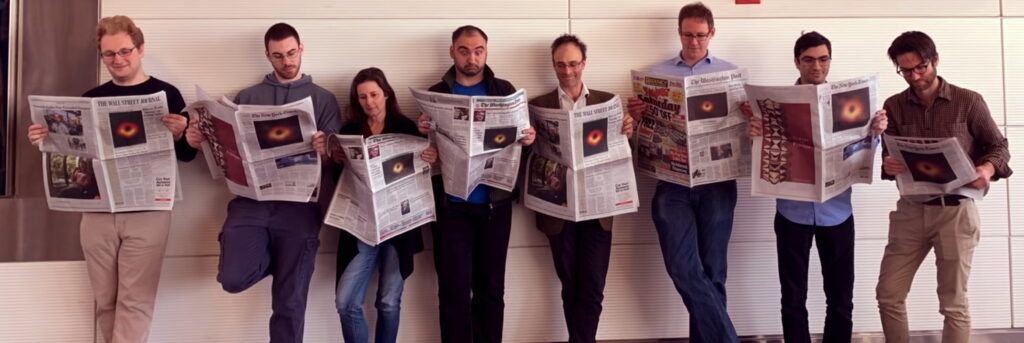
Stunning 1st image of Black Hole
Yesterday (Sep 5, 2019), the Breakthrough Prize Foundation awarded $21.6 million US dollars to the scientists behind a stunning achievement. They imaged a black hole. Although the image was announced and released 5 months ago, the story is still unfolding.
Yesterday (Sep 5, 2019), the Breakthrough Prize Foundation awarded $21.6 million US dollars to the scientists behind a stunning achievement. They imaged a black hole. Although the image was announced and released 5 months ago, the story is still unfolding.
The Breakthrough Prize is funded by Russian-Israeli billionaire Yuri Milner. It is the highest-paying science prize for researchers in life science, math, and physics.
There are many black holes in our galaxy and some small ones in our own galactic “neighborhood” . Yet the EHT team* focused on M87, a black hole in the center of another Galaxy, 55 million light years from our solar system.
This is pretty far, but it is a massive black hole with a bright accretion disk (stuff around the event horizon), and it is orthogonal to our vantage point. How big is the M87 black hole? It is bigger than our entire solar system!
At this unfathomable distance, it is difficult to image anything smaller than an entire galaxy. But by combining data from instruments and math teams around the world, scientists released in April an actual photograph. To be precise, it is the shadow of a black hole, but it clearly shows the accretion disk, event horizon and a hole in the middle. In fact, it shows a perfect, glowing donut.
* The EHT = Event Horizon Telescope
To achieve the implausible, scientists combined data from 8 radio telescopes around the world, including two operated by the European Southern Observatory in Chile (producer of the first video, below). Although data was captured as radio waves, a team of 347 scientists pieced the information together into an actual image. What you see in the paragraph above is not an illustration based on data. It is a genuine photograph.
As you view the 1st video below, you may not feel that it is new. Even with the Big Bang in question, black holes are certain fact, and images have been circulating for years. But—until now—those were all artist’s renderings. There has never been an actual photo of a black hole. This is a first.
A web search turns up many videos about the achievement. Some are less than 2 minutes, and some are 2 hour documentaries. I like these two videos: [1] a 17 minute video documenting the effort to achieve this milestone and clearly explaining the result—and [2] an 11½ minute Ted Talk:
1. In the Shadow of the Black Hole
2. Inside the Black Hole That Made History
Philip Raymond co-chairs CRYPSA, hosts the Bitcoin Event and is keynote speaker at Cryptocurrency Conferences. He is a top writer at Quora.
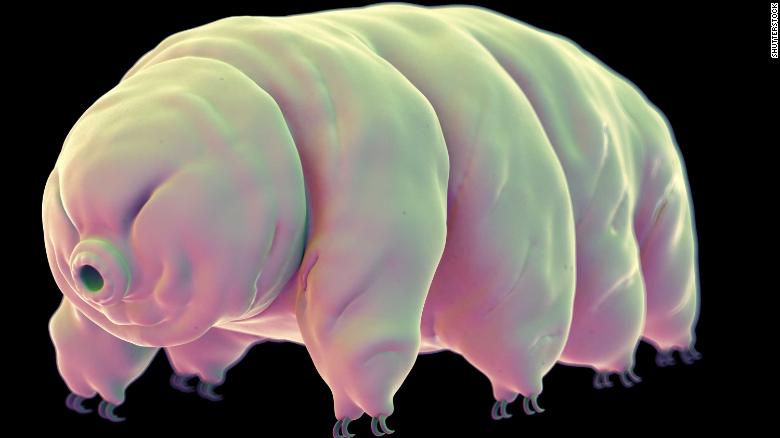
Crashed spacecraft may have left creatures on the moon
(CNN)You’ve heard of men on the moon — but what about moss piglets?
Source: https://www.cnn.com/2019/08/07/world/water-bear-space-intl-scli-scn/index.html

The Search for New Physics & CERN’s FCC Future Circular Collider
It is a few years since I posted here on Lifeboat Foundation blogs, but with the news breaking recently of CERN’s plans to build the FCC [1], a new high energy collider to dwarf the groundbreaking engineering triumph that is the LHC, I feel obliged to write a few words.
The goal of the FCC is to greatly push the energy and intensity frontiers of particle colliders, with the aim of reaching collision energies of 100 TeV, in the search for new physics [2]. Below linked is a technical note I wrote & distributed last year on 100 TeV collisions (at the time referencing the proposed China supercollider [3][4]), highlighting the weakness of the White Dwarf safety argument at these energy levels, and a call for a more detailed study of the Neutron star safety argument, if to be relied on as a solitary astrophysical assurance. The argument applies equally to the FCC of course:
The Next Great Supercollider — Beyond the LHC : https://environmental-safety.webs.com/TechnicalNote-EnvSA03.pdf
The LSAG, and others including myself, have already written on the topic of astrophysical assurances at length before. The impact of CR on Neutron stars is the most compelling of those assurances with respect to new higher energy colliders (other analogies such as White Dwarf capture based assurances don’t hold up quite as well at higher energy levels). CERN will undoubtedly publish a new paper on such astrophysical assurances as part of the FCC development process, though would one anticipate it sooner rather than later, to lay to rest concerns of outsider-debate incubating to a larger audience?
Hope springs eternal. Hearing that folk from China’s IHEP were later in contact with the LSAG on this specific issue, one infers due diligence is in mind, albeit seemingly in retrospect again, on the premise that as CERN take up the baton, significant progress in collecting further input for the overall assessment (eg from cosmic rays, direct astrophysical observations, etc) is expected in the ~20 years timescale of development.
Meanwhile those of us keen on new science frontiers, and large scale engineering projects, have exciting times ahead yet again with a new CERN flagship.
[1] Cern draws up plans for machine four times the size of Large Hadron Collider https://www.theguardian.com/science/2019/jan/15/cern-draws-up-plans-for-collider-four-times-the-size-of-large-hadron
[2] The Future Circular Collider Study (FCC) at CERN https://home.cern/science/accelerators/future-circular-collider
[3] The next super-collider, The Economist, 2018. https://www.economist.com/leaders/2018/01/11/the-next-super-collider-should-be-built-in-china
[4] Reflecting on China’s Ambition to Build the World’s Most Powerful Supercollider, Existential Risk/Opportunity Singularity Management, 2015. http://www.global-risk-sig.org/erosmB9F.pdf
[5] The Next Great Supercollider — Beyond the LHC : https://environmental-safety.webs.com/TechnicalNote-EnvSA03.pdf
[6] Progress in Seeking a More Thorough Safety Analysis for China’s Supercollider http://www.global-risk-sig.org/EROSM7Ui.pdf

Why it is dangerous to build ever larger big bang machines
CERN has revealed plans for a gigantic successor of the giant atom smasher LHC, the biggest machine ever built. Particle physicists will never stop to ask for ever larger big bang machines. But where are the limits for the ordinary society concerning costs and existential risks?
CERN boffins are already conducting a mega experiment at the LHC, a 27km circular particle collider, at the cost of several billion Euros to study conditions of matter as it existed fractions of a second after the big bang and to find the smallest particle possible – but the question is how could they ever know? Now, they pretend to be a little bit upset because they could not find any particles beyond the standard model, which means something they would not expect. To achieve that, particle physicists would like to build an even larger “Future Circular Collider” (FCC) near Geneva, where CERN enjoys extraterritorial status, with a ring of 100km – for about 24 billion Euros.
Experts point out that this research could be as limitless as the universe itself. The UK’s former Chief Scientific Advisor, Prof Sir David King told BBC: “We have to draw a line somewhere otherwise we end up with a collider that is so large that it goes around the equator. And if it doesn’t end there perhaps there will be a request for one that goes to the Moon and back.”
“There is always going to be more deep physics to be conducted with larger and larger colliders. My question is to what extent will the knowledge that we already have be extended to benefit humanity?”
There have been broad discussions about whether high energy nuclear experiments could pose an existential risk sooner or later, for example by producing micro black holes (mBH) or strange matter (strangelets) that could convert ordinary matter into strange matter and that eventually could start an infinite chain reaction from the moment it was stable – theoretically at a mass of around 1000 protons.
CERN has argued that micro black holes eventually could be produced, but they would not be stable and evaporate immediately due to „Hawking radiation“, a theoretical process that has never been observed.
Furthermore, CERN argues that similar high energy particle collisions occur naturally in the universe and in the Earth’s atmosphere, so they could not be dangerous. However, such natural high energy collisions are seldom and they have only been measured rather indirectly. Basically, nature does not set up LHC experiments: For example, the density of such artificial particle collisions never occurs in Earth’s atmosphere. Even if the cosmic ray argument was legitimate: CERN produces as many high energy collisions in an artificial narrow space as occur naturally in more than hundred thousand years in the atmosphere. Physicists look quite puzzled when they recalculate it.
Others argue that a particle collider ring would have to be bigger than the Earth to be dangerous.
A study on “Methodological Challenges for Risks with Low Probabilities and High Stakes” was provided by Lifeboat member Prof Raffaela Hillerbrand et al. Prof Eric Johnson submitted a paper discussing juridical difficulties (lawsuits were not successful or were not accepted respectively) but also the problem of groupthink within scientific communities. More of important contributions to the existential risk debate came from risk assessment experts Wolfgang Kromp and Mark Leggett, from R. Plaga, Eric Penrose, Walter Wagner, Otto Roessler, James Blodgett, Tom Kerwick and many more.
Since these discussions can become very sophisticated, there is also a more general approach (see video): According to present research, there are around 10 billion Earth-like planets alone in our galaxy, the Milky Way. Intelligent life might send radio waves, because they are extremely long lasting, though we have not received any (“Fermi paradox”). Theory postulates that there could be a ”great filter“, something that wipes out intelligent civilizations at a rather early state of their technical development. Let that sink in.
All technical civilizations would start to build particle smashers to find out how the universe works, to get as close as possible to the big bang and to hunt for the smallest particle at bigger and bigger machines. But maybe there is a very unexpected effect lurking at a certain threshold that nobody would ever think of and that theory does not provide. Indeed, this could be a logical candidate for the “great filter”, an explanation for the Fermi paradox. If it was, a disastrous big bang machine eventually is not that big at all. Because if civilizations were to construct a collider of epic dimensions, a lack of resources would have stopped them in most cases.
Finally, the CERN member states will have to decide on the budget and the future course.
The political question behind is: How far are the ordinary citizens paying for that willing to go?
LHC-Critique / LHC-Kritik
Network to discuss the risks at experimental subnuclear particle accelerators
LHC-Critique[at]gmx.com
Particle collider safety newsgroup at Facebook:
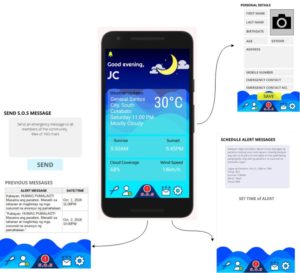
First Pinoy app nominated as global finalist to the NASA Space Apps Challenge
MANILA, Philippines — Among the 2,729 teams in 200 locations all over the world who participated in the NASA Space Apps Challenge, an app made by Filipino innovators was nominated first time by NASA scientists and experts to become a finalist at the global level. Altogether, they will join the top 25 in competing for the six winners of the biggest hackathon in the universe.
The winning app seeking to communicate scientific data to fishermen even without Internet connection was made by IT professionals Revbrain G. Martin, Marie Jeddah Legaspi, and Julius Czar Torreda from team iNON, which stands for “It’s now or never.” Named ISDApp, from the Tagalog word “isda” meaning fish, it sends useful information to fishermen such as real-time weather, sunrise and sunset, wind speed, and cloud coverage to plan their fishing activities in catching more fish using the NASA GLOBE Observer app, a data collection from citizen scientists around the world used in concert with NASA satellite data to identify or communicate information, and educating the public about planet Earth. Fishermen will receive SMS notifications from the Amazon Web Services gateway while local government officials would manage their details using a smartphone app connected to the cloud. NASA scientists and experts consider this fisherfolk app made by Pinoys as one of the solutions “with the most potential to improve life on Earth or in the universe,” therefore nominated as global finalist for Galactic Impact.

The fishermen app won in the local level on Friday-Sunday, October 19–21, 2018 at De La Salle University, Malate, Manila, Philippines, in collaboration with the Embassy of the United States of America to the Philippines and PLDT. US Embassy deputy chief of mission John C. Law, PLDT Enterprise Core Business Research and Development head Leandro T. Santos, DOST-Philippine Council for Industry, Energy and Emerging Technology Research and Development deputy executive director Engr. Raul C. Sabularse, Department of Information and Communications Technology senior planning officer Yvette M. Cabrera, and Animo Labs executive director Federico C. Gonzalez served as jurors at the local level.
An emergency checklist kit app designed for disaster preparedness also won at the local level developed by students Jeorge Loui P. Delfin, Bluen Ginez, Samuel Jose, Rainier G. Narboneta, and Eugenio Emmanuel A. Araullo. Other projects and solutions developed during the hackathon are games using images from the Hubble Space Telescope, augmented reality mobile app to tell a story of the changes in the Arctic and Antarctic ice, artificial intelligence app helping scientists confirm the habitability of exoplanets, and story-based game using NASA Earth imagery. They joined together with teams of coders, scientists, developers, designers, storytellers, makers, builders, technologists, thinkers, entrepreneurs, and everyone around the globe working together in a 48-hour sprint to develop solutions to some of the most pressing challenges on Earth and in space, using NASA resources and data.
https://www.facebook.com/ArchersNetwork/videos/281167132522644
A day-long data bootcamp was held to learn new concepts, strategies and skills from keynote speakers, panelists, and mentors. Michael Carroll from Urban Engine in Huntsville, AL and NASA Earth Science Division senior advisor Dr. Patricia Jacobberger introduced Space Apps through a virtual talk while NASA astronaut Drew Feustel, orbiting aboard the International Space Station welcomed everyone to the event. US Embassy science fellow Dr. Anondo Mukherjee and US Fulbright fellow Sarah Marie Hartman gave an online lecture about the Earth’s environment. DOST-Advanced Science and Technology Institute acting director Dr. Joel Joseph S. Marciano, Jr. and PHL-Microsat program leader Dr. Marc Caesar R. Talampas discussed microsatellite development and advanced technologies in the Philippines.
Several mentors coming from different backgrounds such as YSEALI alumni Ryan Madrid and Malcolm Flores, De La Salle University professors Jordan Aiko P. Deja and Neil Patrick A. Del Gallego, PHL-Microsat engineers Ariston N. Gonzalez, Lorenzo Sabug, Jr., Benjamin Joseph D. Jiao, and Carlo D. Pastoral, Amazon Web Services developers John Luis Garcia, Dennis Magsajo, and Randy Bardaje, Animo Labs incubatee and MachiBox CEO Simon Gregory Mabanta, VR Philippines lead Cristopher David, Mobility IT 4 Youth lead Art Polo Gabriel III, nuclear physicist Dr. Jasmine Albelda, and entrepreneur Ibba Bernardo guided participants in creating their winning apps and solutions to solve problems on Earth and space. Department of Information and Communications Technology undersecretary Monchito B. Ibrahim gave an inspiring message to the participants. IdeaSpace and Animo Labs looked upon promising projects and solutions that might have a business potential.
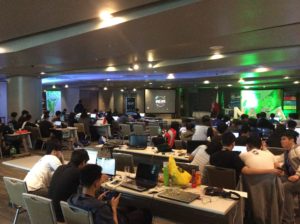
During the hackathon period, teams are expected to find solutions to themed challenges put forth by NASA. They work together with the rest of the world on hackathon weekend to devise creative and innovative solutions to these challenges. Projects do not have to be apps and anyone does not need to become a computer programmer to participate. Participants collaborate to build anything — from open-source software, hardware, data visualizations, and citizen science platforms, to videos, art, and other communications solutions — aimed at addressing global challenges. The overarching theme of the 2018 challenges is “Earth and Space,” underscoring the connections between major challenges, and the potential solutions to them, both on Earth and in space. The 2018 mainstage Space Apps event was hosted by Urban Engine in the US Space and Rocket Center at Huntsville, AL, also known as “The Rocket City.”
Since its inception in 2012, the International Space Apps Challenge has become the world’s largest global hackathon, engaging thousands of global citizens to collaborate in building innovative solutions to complex challenges using NASA’s open data. Hackathons are technology development marathons that draw on the talents and initiative of bright-minded people. Space Apps inspires local innovation communities to convene, cooperate, and create.
The 2018 hackathon was organized by Matt T. Keener, Jeanie M. Duwan, Randolf D. Mariano, and Xavier E. Lara from the American Spaces Philippines of the US Embassy and Kai Shan L. Fernandez, Christine M. Abrigo, Donna Lyn G. Labangon, Kevin Anthony Y. Kaw, and Dr. Rafael A. Cabredo from De La Salle University. Another hackathon was organized at Makati-Bonifacio Global City by Womensphere. In the past years, Tzar C. Umang brought Space Apps in Dagupan, Pangasinan on 2016 while Art Polo Gabriel III, Wilson Censon, and Tito Mari Francis Escaño organized one in PLDT InnoLab in Mandaluyong, Metro Manila. De La Salle — College of Saint Benilde also hosted Space Apps on 2017 by Dr. Edward M. Moises, Norman Lee, and Catherine Valdellon-Mojado.
Lead organizer Michael Lance M. Domagas is very thankful that NASA scientists and experts recognized the skills and talents of Filipinos in building projects and open-source solutions that address real-world problems, on Earth and in space, and hoping that Filipinos would win the competition.

NASA Contest: Design the Gateway Program Graphic
Under Space Policy Directive-1, NASA has been charged with leading a “sustainable exploration of the Moon together with commercial and international partners.”
In response to this bold directive, NASA is working with U.S. and international partners to lead the development of the first permanent human spaceship in orbit around the Moon, known as the Gateway. The Gateway will be a part-time home and office for astronauts farther in space than humans have ever been before.
The Gateway will be important to building a permanent human presence on the Moon. Astronauts will visit at least once per year, living and working aboard the spaceship in deep space for up to three months at a time. NASA is looking at options for astronauts to shuttle between the Gateway and the lunar surface, to explore new locations across the Moon. Even before our first trip to Mars, astronauts will use the Gateway to train for life far away from Earth, and we will use it to practice moving a spaceship in different orbits in deep space.
Just like an airport, spacecraft bound for the surface of the Moon or Mars can use the Gateway to refuel or replace parts. The Gateway’s core functions include power and propulsion, communications, habitation, logistics resupply, robotics, and an airlocks for science and spacewalks.
By partnering with U.S. companies and international partners to design and build the Gateway, NASA will ensure this groundbreaking lunar laboratory is available to multiple users, providing more access to the Moon than ever before.
You can learn more about the Gateway with this quick Q&A: https://www.nasa.gov/feature/questions-nasas-new-spaceship
The goal of this challenge is to develop a graphic to represent the Gateway. The product should graphically convey the key theme of space exploration and what the Gateway represents. The graphic will be used in multiple ways internally at NASA, but will have limited external/public use, if any. A small version of the graphic may be used in the top corner of documents, a larger version could be used on the title page of internal presentation materials, or the graphic may be used on other products developed by the NASA Gateway team.
Graphic Requirements
- Both a color version and black/white version are required.
- Source File Requirements: All original vector source files of the submitted design. Files should be created in Adobe Illustrator or Inkscape and saved as layered AI or EPS files. Note that PSDs saved as EPS files are not true vector / scalable files and will not be accepted.
- All fonts (and operating systems) must be listed in a text file within your Submission Zip file. Include the name of the font and a link to where it can be downloaded/purchased. DO NOT include any font files in your submission or source files.
- All text in the graphic should be converted to outlines.
- Submission should also include 1024 x1024 version of the graphic in jpeg or png (on both a black background and a white background). The NASA insignia or other NASA logos cannot be used as any part of the submission.
Other Preferences
- Color pallet is open, but limited to 6 colors.
- Please avoid gradients or other special effects as they are difficult to reproduce across all media.
Stock Photography Requirements
- Stock photography is not allowed in this contest. All submitted elements must be designed solely by you.
Judging Criteria
- Requirements: Does your submission meet the requirements as stated within the challenge?
- Quality: Does your submission look fresh, professional, and clean?
- Concept: Does your submission represent what the Gateway stands for?
Please note that NASA employees/contractors are not eligible for competing in this contest.
Supported Submission File Types
- JPG
- PNG
- GIF
Join the Contest
https://www.freelancer.com/contest/NASA-Contest-Design-the-Gateway-Program-Graphic-1451793.html

IdeaXme — Ambassadors — Ira Pastor
Space, Oceans, Literature, Entertainment, Sports, Medicine, Fashion, Longevity — Honored to be among this group of thinkers, coming up with the innovative ideas that shape the future — http://radioideaxme.com
